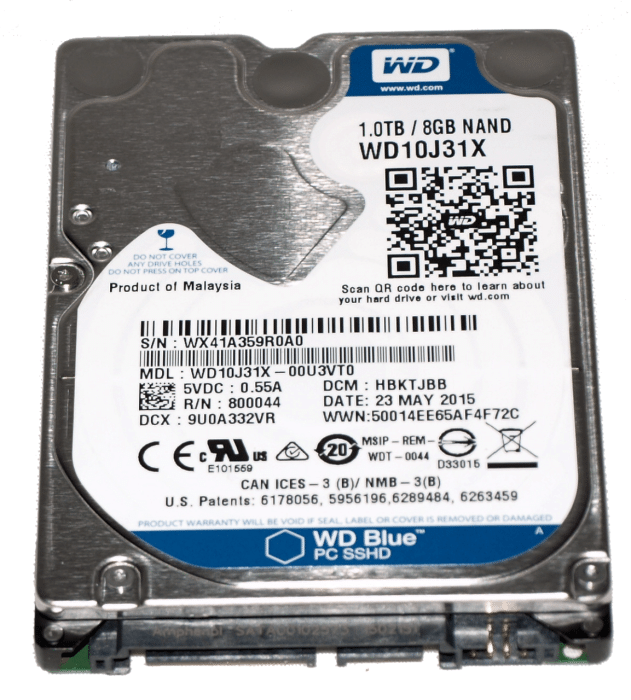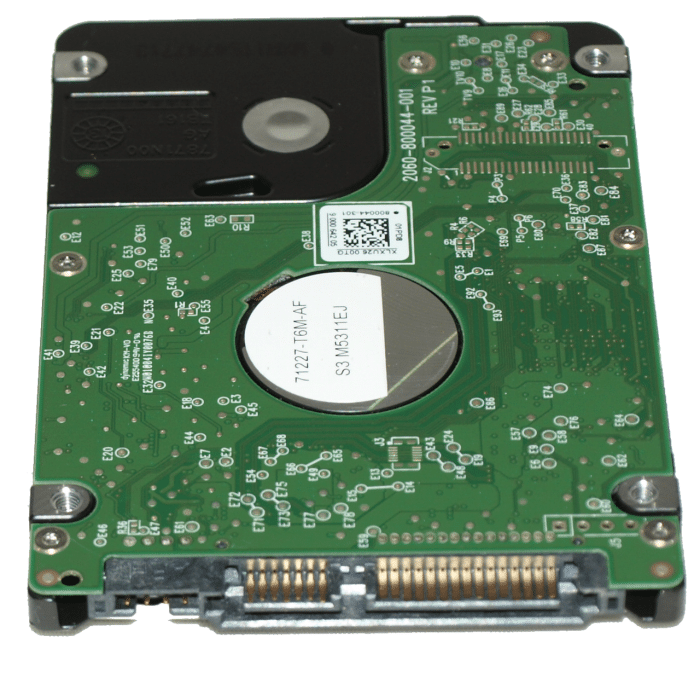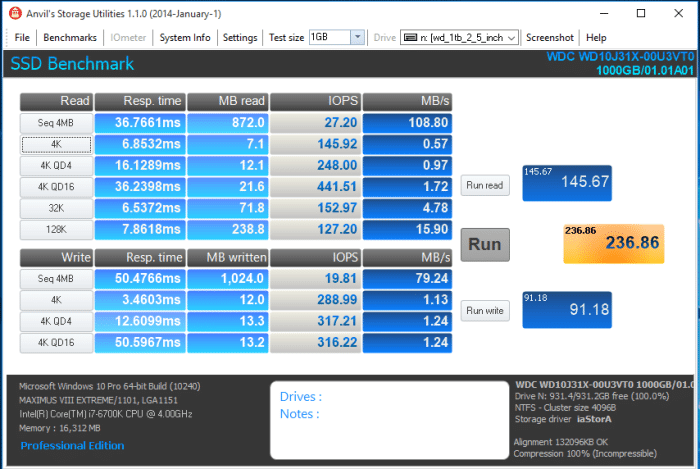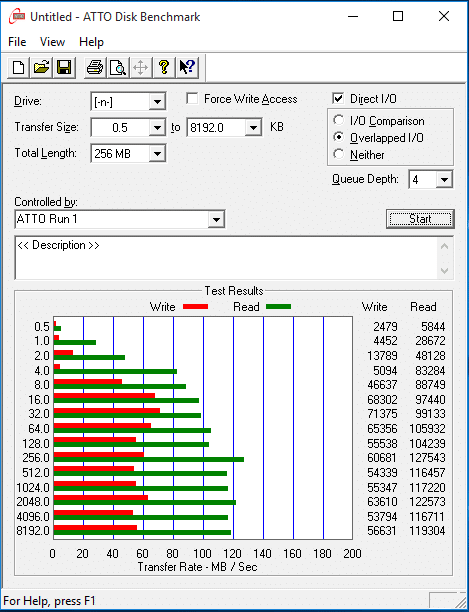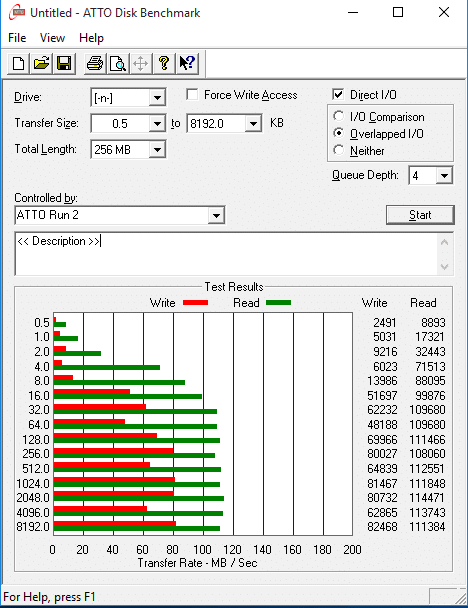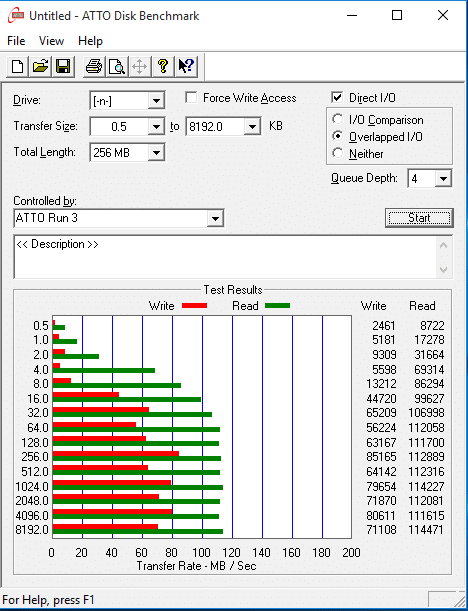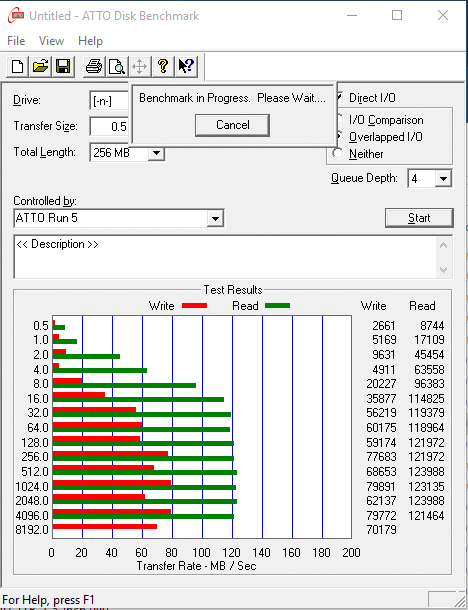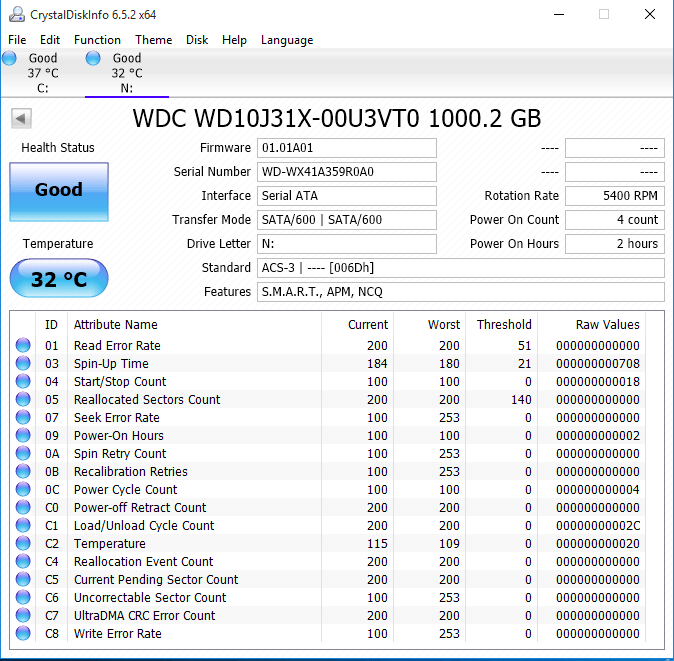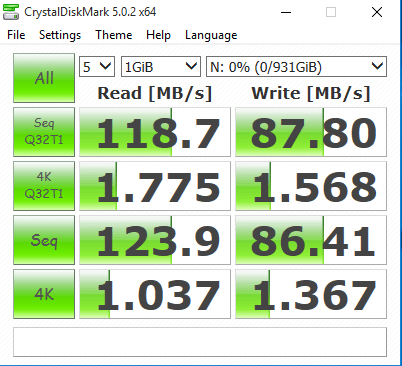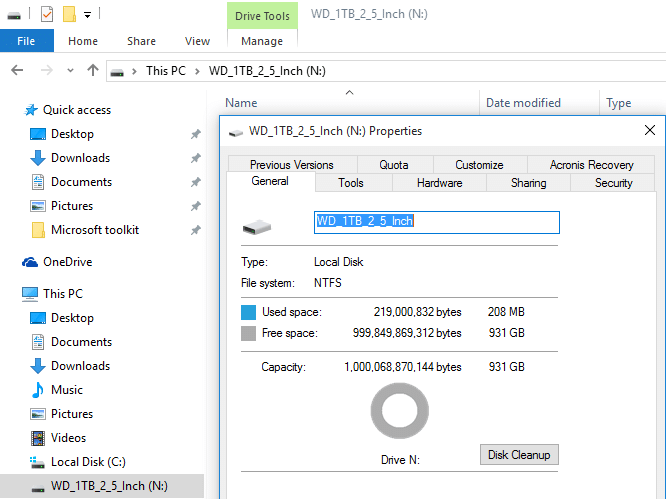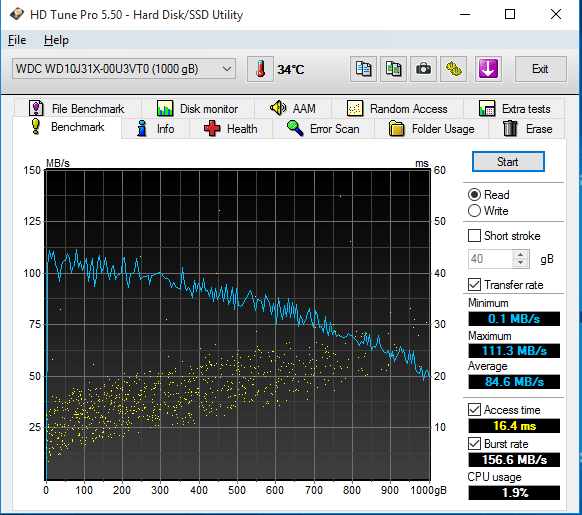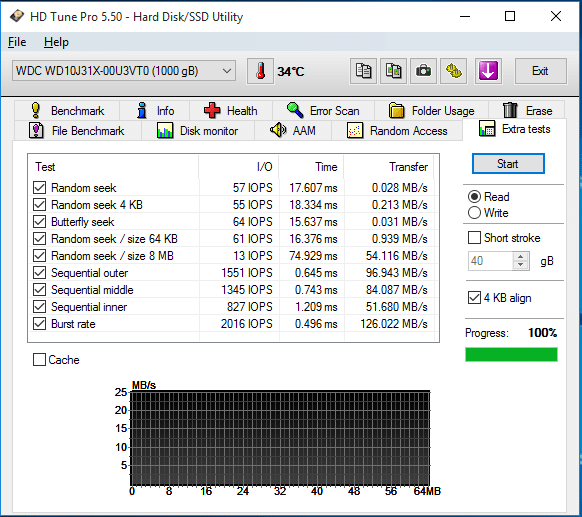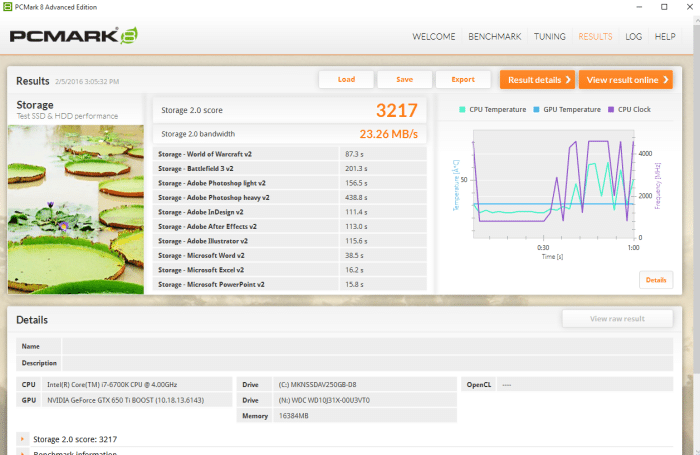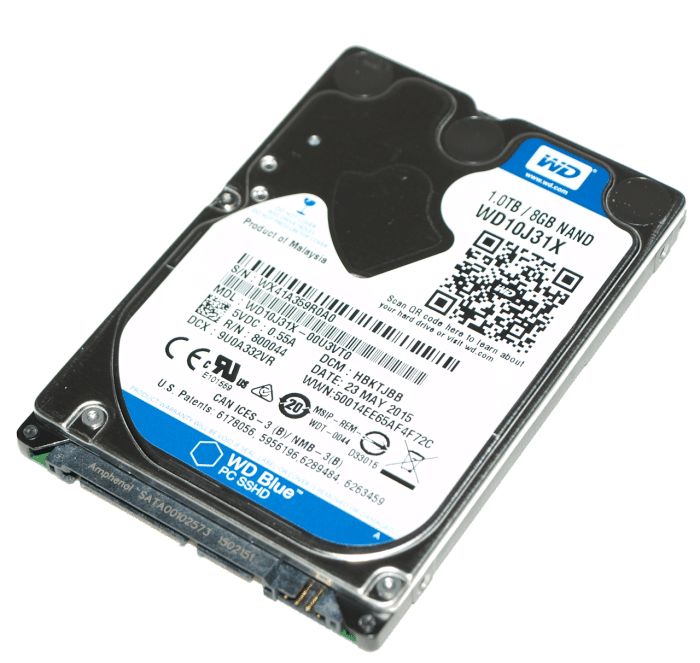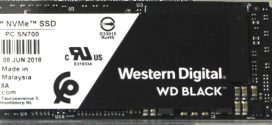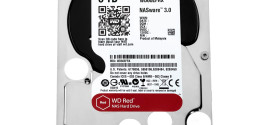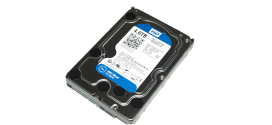Western Digital Blue 1TB SSHD
With the myriad of hard drives appearing in the last couple of years it can get pretty confusing on what to pick for what applications or machine you use. If your going for blazing speed at a cost just doesn’t matter then a NVME M.2 or PCI-E MVME probably makes sense on a board that supports them. Need massive storage but top speed isn’t the priority, maybe a 1 TB SSD in the $1000 price range is fit for your pocket book. Massive storage then NAS with massive platter drives might fit the bill. How about that aging laptop with one drive bay that only fits 2.5 inch drives and like most of us you still have to put Cherrios on the table this month. Western Digital offers a Blue 1 TB SSHD with the storage suitable for a 1 drive bay Laptop where budget is a concern.
The Western Digital Blue 1TB SSHD is a blending of 8 GB of fast NAND flash inside a platter drive. They offer both 3.5 inch (4 TB) and 2.5 inch (1 TB) and the 1 TB model is extremely suited for single bay Laptops where you don’t want to (or can’t) send $1000 for a 1 TB SSD yet still need large storage for your media su ch as music, movies or even media creation like animation or CAD application.
Leveraging an 8 GB Nand flash SSD portion with a Smart Cache design and a 1 TB platter HD backing it up you get the extra boost of an 8 GB SSD and the massive storage offered by affordable platter drives. It’s the best of both worlds in a limited drive bay situation and truthfully you could do a lot worse in any HD situation than the Western Digital 1 TB SSHD 2.5:” form factor.
As mentioned the Western Digital 1 TB SSHD sports a standard 2.5″ form factor with a 9.5mm height suitable for most Laptops and all desktops. Certain laptops take a shorter drive at 7.5mm or less so check your manufacturers specifications before choosing your HD. Some of the ultra thin models and a lot of the Lenovo’s used a 7.5mm so check just to make sure your not the odd laptop in the pile.
Utilizing a standard SATA 6 Gb/s interface the ! TB SSHD with and SATA capable machine. As with many things the computer vendors have complicated things and Chrome Books and Tablets normally use a smaller M.2 or proprietary embedded storage solution so check that your machine supports SATA. We’d estimate that more than 90% of all machines support SATA but if you don’t know for sure rub elbows with your techie buddy and they can tell you.
Specifications
WD BLUE SSHD
- Ideal for:
- High-performance PC systems
- Notebooks
- Desktops
- All-In-One PCs
- Gaming PCs
- Home Media PCs
- Specifications:
- 1 TB 2.5-inch and 4 TB 3.5-inch capacities
- 8 GB of NAND flash for blazing SSD-like performance
- Up to 5x faster than traditional 5400 rpm HDDs
- Designed for power PC users, creative professionals, gamers and system builders
- 3-year limited warranty (worldwide)*
Test Rig & Benchmarks
There’s really no big need to go into the entire test rig we used, we used an Asus Maximus VIII Extreme motherboard with a 6700K Skylake processor under triple radiator water cooling to prevent any throttling. We set a 550MB/s SSD as the boot drive using Windows 10 fully updated with the latest drivers and all updated software. We ran the Rig at stock speed as well as the GPU at stock speed for all the WD SSHD testing. You can scrape a little more speed out of the drive in some instances OC’d but since you don’t OC the drive itself we went with a stock speed system. Now we normally use a 480GB PCI-E M.2 ultra fast drive but that’s just not reality for most end users so we cloned that drive to a normal SSD.
We also test on a desktop rig as Laptop chipsets sometimes fall short on being able to run drives at their full speed. Using a desktop shows you the potential of the drive to it’s fullest extent. If you happen to have an aging 4 or 5 year old laptop your chipset might not give you prime speeds from any modern drive. Most laptops built in say the last 3 years should have improved chipsets capable of driving most HD’s to their full speed.
For those that absolutely must have the extreme lowdown on the Test Rig:
| Test Rig “Quadzilla” |
|
| Case Type | |
| CPU | |
| Motherboard | |
| CPU Cooler | |
| Hard Drives | |
| Optical | Liteon DVD Burner |
| GPU | |
| Case Fans | 1 x 180mm Mosfet / CPU / RAM cooling fan 1 x 120mm PCI-E Cooling Fan |
| Docking Stations | None |
| Testing PSU | |
| Legacy | None |
| Mouse | |
| Keyboard | |
| Any Attempt Copy This System Configuration May Lead to Bankruptcy | |
Benchmarks
Anvils Storage Utilities
Anvil’s Storage Utilities is a powerful tool that was designed in order to provide you with a simple means of assessing the read and writer performance of your Solid State Drive or Hard Disk Drive.
The benchmark tool helps you monitor and check the response time of your unit as well as view the system information collected using Windows Management Instrumentation (WMI).
Anvil’s Storage Utilities has been designed to be the most comprehensive benchmark tool for Solid State Drives on the market. That does not mean that you can’t use it for conventional platter based drives as well, but you do get the most out of the program when you test the speed and performance of SSDs with it. The program has gone through a series of beta and release candidate builds already, and is currently available as Release Candidate 3. It is usually linked from this forum thread, which currently is not the case for the RC build which you can download here directly. You can’t use previous builds as they are set to expire automatically.
You can run a benchmark right away by selecting a drive from the menu at the top right, or check out the settings first to make sure everything is configured correctly here. Here you can simulate a compression level of the test file, e.g. database, application or uncompressed, and whether you’d like to use the same test file on consecutive runs or generate a new one every time. As far as benchmarks go, you can run a standard SSD benchmark that is testing read, write, or both performances of the drive, or run threaded IO benchmarks only.
We like Anvil because it goes beyond just raw speeds and give IOPS, MB read response time and the MB/s read and written giving us a wider field of view on a drives performance. The Western Digital Blue 1 TB SSHD shows 108.80 MB/s Seq 4MB with 872 MB read at 27.20 IOPS which is pretty decent for a 2,5 inch 5400 RPM drive. In most cases this will outperform a 7200 RPM drive without a SSD cache but the big advantages here are the SSD cache and the lower power consumption which has become so vital to Laptop operation. As you can see the SSHD slows down some on the smaller reads and writes but typically the smaller reads and writes are so small that they occur in a blink of an eye taking no appreciable time.
ATTO
Assess the performance of your HDD and run thorough hard disk drive tests to determine read and write speeds by using this powerful application
In case you notice it takes a considerable amount of time to read or write data, you might want to put it to the test and see if everything is in order. ATTO Disk Benchmark is a software solution designed to help you measure the performance of your system, by running a series of tests to determine hard disk speed.
ATTO is almost the industry standard for reporting drive speed from the manufacturer and we will be running multiple passes of ATTO to check on the learning portion of the SSD.
The ATTO run like all other runs starts with cleared caches in Windows. The first run gets cleared caches but all the runs after that we don’t clear any cache or make any changes to the OS. After the ATTO runs we again clear caches and continue on with the other tests. We don’t want to interfere with the drives learning algorithms in any way.
Here in Run 1 we see the 0.5K at 2.479 MB/s write and 5.844 MB/s with speeds generally increasing as the Read / Write sizes increase. We top out at a respectable 127.453 MB/s which is fantastic for any 5400 RPM drive and that’s on the first run before the “learning” kicks in.
Run 2
Here on Run 2 we see the 0.5K size block picking up a little speed but as we’ve sen on other SSHD’s the second run seems to confuse the learning code and our top speed drops to 114.471 which again is still 3 or 4 times as fast as many 5400 RPM drives.
Run 3
Here on run 3 the speeds are pretty level and inline with the second run so we aren’t seeing much improvement in the third test. Keep in mind the limited time available for testing, most intelligent learning code takes time to get settled on what you are going to use most and after the learning period then the correct apps are in the cache to give you the extra speed you crave.
Run 4
Here on run 4 we are seeing some improvement on some of the different sized blocks but we haven’t gotten back to the first runs top speed of 127 MB/s. Perhaps the caches not being emptied are affecting the drives electronics but most end users don’t boot up with the first thought of clearing their cache each day. We also run testing with a light weight anti-virus running as is normal for end users but we have switched it off and made 5 passes at the same drive and it’s running didn’t affect overall speeds.
Run 5
Here on run 5, the last run, we are seeing numbers climb from the 2nd, 3rd and 4th run indicating to us that the learning portion is kicking in and starting to do it’s job of caching most used data. We made subsequent runs with each run increasing performance slightly up to the 10th run when we had to move on but the gains from this point on ere pretty minimal. Again this isn’t the best environment for a learning algorithm to perform in but we are getting indications that it is performing correctly.
CrystalDiskInfo
CrystalDiskInfo gives you a complete readout of all your computer’s SMART information, as well as a current temperature and health status. From its dashboard, you can quickly see a long list of up-to-date system data, so you know when things are going well, and if it seems like something is going wrong.
We like CrystalDiskInfo because it gives you a quick snapshot of a drives specifications and as you can see the drive is pretty mush what Western Digital advertises except that CrystalDiskInfo hasn’t caught up to SSHD technology so it’s not seeing the k GB Nand Flash embedded in the drive.
CrystalDiskMark
CrystalDiskMark is a disk benchmark software.It measure sequential reads/writes speed,measure random 512KB, 4KB, 4KB (Queue Depth=32) reads/writes speed,select test data (Random, 0Fill, 1Fill),provide theme support and Multi-Language support.
top end speeds on CrystalDIskMar are 118.7 MB/s read and 87.80 Write which are pretty respectable speeds for 5400 RPM drives.
OS Reported Charistiscs
We went into Drive Explorer and called up the Western Digital 1 Tb SSHD’s properties and given the method commonly accepted for measuring disk size the drives size is correct and we assigned an out of the way free drive letter “N” so as no to confuse the drive with any other drive in the system we might be using.
HD Tune Pro
HD Tune Pro is a hard disk / SSD utility with many functions. It can be used to measure the drive’s performance, scan for errors, check the health status (S.M.A.R.T.), securely erase all data and much more.
HD Tune Pro gives us graphical information about the drives performance across the platters and typicall atthe outer edge of the platter performance is higher and as the red head gets closer to the center performance drops some. THe MaxSpeed of the drive is 111.3 MB/s with an average of 84.6 MB/s and an access time of 16.4 MB/s, We don’t pay much attention to the burst rate as it’s usually a cache hit heavy reading but we are liking the low CPU usage. A lot of SSD’s sure they are performing at uber speeds but they drive the CPU much harder keeping up with the data flow. So speed is a two edged knife, take an SSD and it can drive the CPU up around 12 – 14% usage depending on the drives activity but at other times when data needs decrease the CPU usage is much lower. You trade Drive speed for CPU usage and generally drive speed will win out over CPU usage as CPU’s have gotten so massively powerful they have the extra headroom to run a SSD.
The Extra tests portion of HD Tune Pro is probably better than the front screen and gives you more in depth info on the drive. Random Seek we get 57 IOPS with a response time of 17.607 on a small transfer of 0.028 MB/s. One of the advantages of HD Tune Pro is it measures outter platter, middle platter and inner platter which is rare in Drive utilities. For the inner platter we get 51.680 MB/s the middle platter we get 84.087 MB/s and the outer platter we see 96.943 MB/s. We ran HD Tune Pro Extra tests 3 times and took the median run to report.
PCMARK 8
Real-world relevance
What makes PCMark 8 different from other benchmarks? Real-world relevance.
With PCMark 8 you measure and compare PC performance using real-world tasks and applications. We’ve grouped these applications into scenarios that reflect typical PC use in the home and at the office.
This approach ensures that PCMark measures the things that matter, highlighting performance differences that will be apparent to end users and consumers.
PCMark 8 for some odd reason uses 5 different Adobe functions which are all completely incomprehensible media so we have every other benchmark showing above 100MB/s read and entirely respectable write speeds and PCMark 8 claims “Real World Relevance” but the score drops to 23.26 MB/s because someone thought the entire world revolves around Adobe. We would tend to think the other benchmarks are more real world relevant and rely more on those for scoring and awards than PCMark 8 which reports a drastically different score. We present the score for those few that use Adobe extensively and because it’s a commonly referenced if flawed benchmark. The overall score is 3217 and over all we are extremely pleased with the Western Digital Blue 1 TB SSHD’s speed and performance.
Final Thoughts & Conclusion
The Western DIgital Blue 1 TB SSHD is a marvel of technology melding a platter drive with an 8GB SSD running at 5400 RPM and providing 3 – 4 times the speed of 
The Western Digital Blue 1 TB SSHD offers great speed in a 2.5″ form factor with an extremely economic price when compared to SSD’s. You don’t have to settle for a vanilla platter drive or a smaller expensive SSD you can travel the middle road and enjoy some of the benefits of an SSD and the mass storage offered by platter drives. Platter drives still have a lot of life in them and in day to day life coming into contact with a couple of hundred PC’s a month it’s fairly rare to see a PC with an SSD, almost all we deal with are platter drive PC’s and the occasional enthusiast build with a SSD up front and guess what, a platter drive backup storage because the SSD’s are to expensive to cover all the end users storage needs. That places the SSHD’s in an advantageous position and we are entirely surprised that mass PC manufacturers aren’t including a SSHD as an improvement over the usual 5 year old technology cheapo drive they usually use.
Step into the 21st Century and enjoy the benefits of a Western Digital Blue 1 TB SSHD and increase the speed of your off the shelf PC, laptop or HTPC with it’s learning algorithms and 3 – 4x speed increase over the 5400 RPM drives usually found in laptops.
*To answer our teaser line in the title the Western Digital Blue SSHD is a platter drive with an integrated 8GB SSHD. We eagerly await the further melding of SSD and platter and hope to see 128GB SSD’s integrated into the platter drives furthering the Nand flash leverage of the SSHD’s. A 256GB SSD integrated would just send us running down the street hilariously happy.
| Pros | Cons |
|
|
 Bjorn3D.com Bjorn3d.com – Satisfying Your Daily Tech Cravings Since 1996
Bjorn3D.com Bjorn3d.com – Satisfying Your Daily Tech Cravings Since 1996

